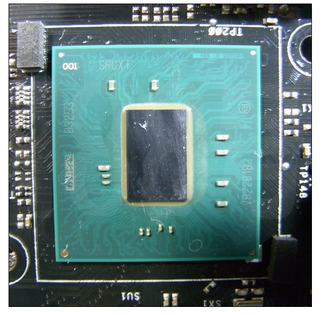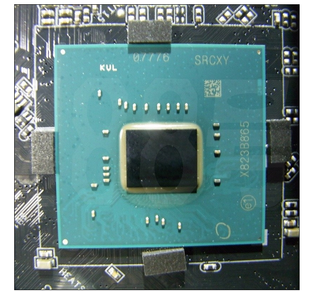Intel Tock-Ticks Chipsets Back to 22nm
We've confirmed through multiple sources that Intel is fabbing its new H310C chipset on its 22nm process. That means the chip-making giant has taken a step back to an older process for the H310C chipset as it struggles with its ongoing shortage of 14nm processors. Contrary to recent reports, our sources confirmed Intel manufactures these chips and not TSMC (which has been reported in recent weeks), though that could be subject to change in the future.

The shift in Intel's strategy comes as the company struggles with the fallout from its chronically delayed 10nm process. Now the company is dealing with an increasingly loud chorus of reports that Intel's 14nm shortage is now impacting its server, desktop and mobile chips.
The worrying lack of motherboards with the H310 chipset, which began back in March, served as the first sign of an impending shortage of Intel's 14nm silicon. In May, reports surfaced that Intel had suspended production of the chipset, and in July, the company finally acknowledged a much larger issue with 14nm production capacity.
Intel typically produces chipsets on a larger node than its current-gen processors, but the delayed 10nm production has found both chipsets and chips on the same 14nm node, creating a manufacturing bottleneck as the company experiences record demand for 14nm processors.

Word of a new H310C chipset surfaced last month. Leaked images of the new H310C on mydrivers.com revealed that the new H310C, which measures 10 x 7mm, is much larger than the 14nm H310, which measures 8.5 x 6.5mm.
However, the increased physical size alone doesn't confirm that Intel is fabbing the new chipset on a larger process, so we reached out to several contacts and confirmed the change.
Intel hasn't commented on the matter, saying it doesn't comment on unreleased products. However, motherboards with the new chipset are already moving out into the supply chain, meaning that Intel will soon publish a formal specification sheet, much like the H310 specs, that confirms the change.
Stay on the Cutting Edge
Join the experts who read Tom's Hardware for the inside track on enthusiast PC tech news — and have for over 25 years. We'll send breaking news and in-depth reviews of CPUs, GPUs, AI, maker hardware and more straight to your inbox.
Our sources indicate that vanilla H310 motherboards will continue to be offered at retail locations, but they fully expect the H310C motherboards, which will be branded with either an H310C or H310 R2.0 branding, to replace the existing SKUs eventually. The new chipsets will also support Windows 7, as reported by our sister site AnandTech, which may signal that Intel will restore compatibility with the older OS on its newer motherboards, such as the forthcoming Z390 lineup (EDIT: we've learned this support comes as a byproduct of motherboard drivers and is not borne of an innate characteristic of the chipset).
Currently, the 14nm chipsets are exacerbating manufacturing challenges in Intel's 14nm foundries. In most cases, the company has to create one chipset for each processor, so easing that production load would free Intel up to produce more 14nm Coffee Lake processors. For Intel, it makes a lot of sense to move back to the 22nm process for its chipsets: performance and power consumption also isn't as much of a concern with the low-end chipsets, and, most importantly, the tiny chips generate very little margin. That means Intel stands to lose little from going back to an older node that may cost slightly more to produce.
We don't expect Intel to move its desktop or server processors back to the 22nm node, but it is possible that it may migrate other chipsets back to 22nm. It's also possible for Intel to move other low-margin parts back to an older process, or to explore outsourcing some of its production in the future.

Paul Alcorn is the Managing Editor: News and Emerging Tech for Tom's Hardware US. He also writes news and reviews on CPUs, storage, and enterprise hardware.
-
takeshi7 Is this the first ever instance of redesigning a chip to work on a larger process node?! It's the only example I'm aware of.Reply -
InvalidError Reply
I bet this is far more common than you might think, we just don't hear about it as much because most of it is happening on chips nobody other than affected product engineers are tracking. For example, few to no people know or care about what chips are being used in their SmartTVs, SmartFridge, wireless speakers, etc.21334572 said:Is this the first ever instance of redesigning a chip to work on a larger process node?! It's the only example I'm aware of. -
pct8750 Z370, H310C?200 Series Chipset.Reply
Please compare H310C and Z370 pics with 200 Series Chipset pics.
Those all look the same to me!
USB 3.0 xHCI Host Controller on 200 Series Chipset, Z370, and probably H310C
DeviceID:A2AF
There are USB drivers for Windows 7.
USB 3.0 xHCI Host Controller on H370, B360, H310
DeviceID:A36D
There are no USB drivers for Windows 7.
Intel has not released Windows 7 USB 3.0 drivers for DeviceID:A36D. -
Paskek Well the 22nm works fine it just takes about 30% more power draw compare to the 14nm chipsets.Reply
Since Intel currently lives and die by their 14nm++ it's logical to sacrifice a little on the efficiency for Intel's customers that got the older gen process boards in order for Intel to pump out more of their higher margin products like processors so Intel could make more money. -
DavidC1 Intel also needs to ship 200 million 14nm LTE modems to Apple. That is likely a big reason for supply constraints.Reply -
stdragon Reply21335554 said:Well the 22nm works fine it just takes about 30% more power draw compare to the 14nm chipsets.
Since Intel currently lives and die by their 14nm++ it's logical to sacrifice a little on the efficiency for Intel's customers that got the older gen process boards in order for Intel to pump out more of their higher margin products like processors so Intel could make more money.
So long as it's used for desktop and not laptops, I guess it will have to suffice for now.
Most Popular






